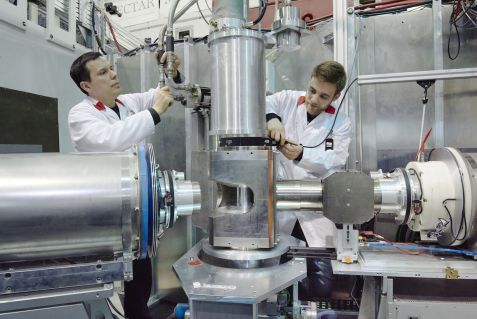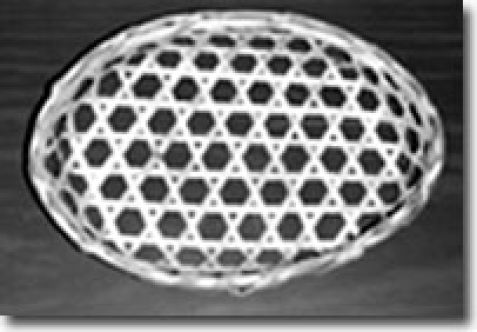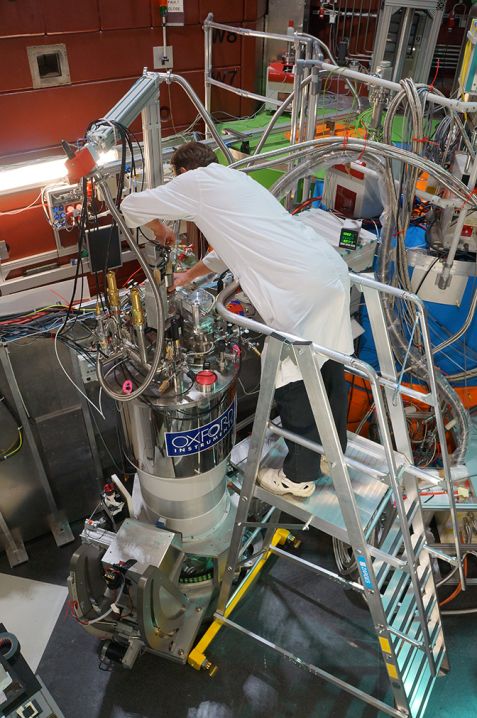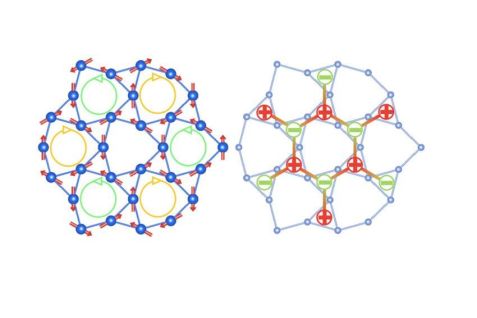MLZ is a cooperation between:
 > Technische Universität München
> Technische Universität München > Helmholtz-Zentrum Hereon
> Helmholtz-Zentrum Hereon
 > Forschungszentrum Jülich
> Forschungszentrum Jülich
MLZ is a member of:
 > LENS
> LENS > ERF-AISBL
> ERF-AISBL
MLZ on social media:

MLZ (eng)
Lichtenbergstr.1
85748 Garching
20.03.2020
North pole without south pole: Magnetic monopoles detected

Dr. Vladimir Hutanu (left), who examined the magnetic monopoles, and PhD student Henrik Thoma at the instrument POLI. © Wenzel Schürmann / TU München
Breaking a magnet into two pieces, reveals a north and a south pole in each of them. Independent magnetic monopoles have been known as emergent excitations in one special class of magnetic crystals only. An international team of researchers has now for the first time detected magnetic monopoles with neutrons in a material that conducts electricity.
In crystals there is a strict order: each atom occupies a fixed place. Ice, in other words frozen water, represents an exception. Here, the hydrogen atoms can occupy different orientations. The only condition: they have to fulfill the so-called ice rule. According to this rule, each oxygen atom must have exactly two strong and two weak bonds to the neighbouring hydrogen atoms.

Japanese basket showing the kagome pattern. © wikipedia (https://en.wikipedia.org/wiki/Trihexagonal_tiling)
Atomic arrangement as in woven baskets
“Systems with such constraints can show novel properties,” says Prof. Dr. Philipp Gegenwart from the University of Augsburg. One example is the “Kagome spin-ice”, which has so far only been a theoretical concept.
In Japanese, “Kagome” means basket grid. Braided baskets with a Kagome pattern have triangles that are connected to each other at the corners. Atoms can also crystallize in this structure. It becomes interesting when they carry a magnetic moment, a so-called spin. Because of the triangular arrangement, it is impossible to align the spins of neighboring atoms in the usual way. As is the case with water molecules in ice, the possibilities of spin arrangements are therefore limited – hence the name Kagome spin-ice.
Kagome spin-ice behaves as if it contains magnetic monopoles and not spin triangles. There are actually no individual magnetic poles, because even elementary particles always carry a pair of north and south pole.

Technician Wolfgang Luberstetter operating the 8-Tesla magnet, which the sientists used for their experiments. © Vladimir Hutanu / RWTH Aachen
First detection of Kagome spin ice
More than ten years ago, monopole quasi-particles were first detected in spin-ice materials. These materials are electrically insulating. An international research team has now detected Kagome spin ice for the first time. They investigated the metallic compound HoAgGe, which contains spins on a Kagome-like lattice.
Neutron measurements with a high-field magnet
The researchers exposed the substance to a magnetic field at various temperatures. They also carried out some of their experiments on the MLZ neutron diffractometer POLI, jointly operated by Forschungszentrum Jülich and RWTH Aachen University at the Heinz Maier-Leibnitz Zentrum. Using the high-field superconducting magnet recently commissioned at POLI, they could determine the orientation of the single interacting magnetic moments of the atoms in the crystal lattice, the so-called magnetic structure. “This can only be done by neutron diffraction,” explains the instrument scientist, Dr. Vladimir Hutanu. The scientists from Jülich and Aachen carried out both the neutron measurements and also participated in the analysis of the results, in cooperation with their international colleagues.

In HoAgGe, the Ho spins occupy a Kagome structure. The arrows indicate the orientation of spins (left), following the ice rule in triangles: “two-in-one-out”, namely one positive magnetic charge, or “one-in-two-out”, namely one negative magnetic charge. Thus, the ground state can also be viewed as a honeycomb of magnetic monopole quasiparticles (right). © Universität Augsburg
Material conducts electricity
Depending on its strength, they generated a number of different spin arrangements, all of which obeyed the ice rule. In theoretical simulations, the researchers also revealed the differences to the Kagome spin ice theory. In contrast to previous spin-ice materials, HoAgGe also conducts electricity. In the future, the scientists therefore want to investigate more closely how the conduction electrons interact with the magnetic monopoles. “Such interaction can enable new magnetoelectric effects, perhaps even with application potential”, speculates Philipp Gegenwart.
Original text: University of Augsburg / Forschungszentrum Jülich
Original publication:
Kan Zhao, Hao Deng, Hua Chen, Kate A. Ross, Vaclav Petříček, Gerrit Guenther, Margarita Russina, Vladimir Hutanu und Philipp Gegenwart:
Realization of the kagome spin ice state in a frustrated intermetallic compound.
Science 3 Mar 2020: Vol. 367, Issue 6483, pp. 1218-1223,
DOI: 10.1126/science.aaw1666
Further information:
The work was partially supported by the German Science Foundation (DFG) through the collaborative research center TRR 80 (“From electronic correlations to functionality”, spokesperson: Prof. Dr. Philipp Gegenwart) and the priority program SPP 1666.
MLZ is a cooperation between:
 > Technische Universität München
> Technische Universität München > Helmholtz-Zentrum Hereon
> Helmholtz-Zentrum Hereon
 > Forschungszentrum Jülich
> Forschungszentrum Jülich
MLZ is a member of:
 > LENS
> LENS > ERF-AISBL
> ERF-AISBL
MLZ on social media:


